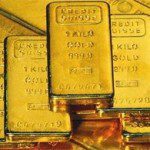Gold’s rarity – there is only 1 gram of gold for every 250 tonnes (550,000 lbs) of earth – means that finding economic deposits is extremely difficult…This article gives an overview of every aspect of the gold supply including:
economic deposits is extremely difficult…This article gives an overview of every aspect of the gold supply including:
- how gold deposits are created,
- the major types of gold deposits to know,
- how much gold is left in the ground,
- all-in cash costs per ounce of gold,
- the global gold supply – past & future and
- who owns the gold.
So says Jeff Desjardins, President of Tickerscores.com, in edited excerpts from his original article* entitled The Definitive Guide To Global Gold Supply.
[The following is presented by Lorimer Wilson, editor of www.munKNEE.com and may have been edited ([ ]), abridged (…) and/or reformatted (some sub-titles and bold/italics emphases) for the sake of clarity and brevity to ensure a fast and easy read. This paragraph must be included in any article re-posting to avoid copyright infringement.]
Desjardins goes on to say in further edited excerpts:
1. How Gold Deposits Are Created
…Gold mineralization typically occurs when it precipitates out of hot fluids and is deposited into host rock. Gold, initially dissolved in hot water deep in the crust and under immense pressure, is transported and deposited upwards as the water travels up cracks and fissures towards the surface.
2. The Major Types of Gold Deposits
Deposits come in many different forms:
- Placer deposits are formed when erosion exposes veins of gold. The gold, because of its density, eventually is moved by earth’s forces such as water and gravity. Gold nuggets found with gold panning are created in this manner.
- Volcanogenic Massive Sulphide (VMS) deposits are formed at or near the sea floor by underwater volcanic activity. They can be a significant source of copper, zinc, lead, gold, and silver.
- Epithermal deposits are created close to surface and are deposited by hot fluids. These occur typically in areas where magmas are able to move high in the Earth’s crust. Gold, silver, copper, and other metals are found in epithermal deposits.
- Porphyry deposits are the single most important source of copper and molybdenum today. Also sometimes containing gold, they form when a column of magna rises and cools in two stages, trapping rich localized zones of minerals.
- Carlin-type deposits occur chiefly in Nevada, where the gold is “invisible” to the naked eye by being disseminated throughout the sedimentary rock. Almost always, these are hosted in carbonate rocks.
- Orogenic deposits form during (“mountain forming”) events when tectonic plates collide. The gold, along with other minerals, is often precipitated in quartz.
There are other types as well, but the above deposits are the most common sources of gold today.
3. a) How Much Gold Is Left In the Ground?
According to our 2013 World Gold Deposit Rankings, a report which summarized all gold deposits in the world over 1 million ounces,
- the total amount of gold left in the ground is a total of 3.72 billion oz (115,700 tonnes)
- of which, based on a best estimate provided by Natural Resource Holdings, only 1.82 billion oz (56,600 tonnes) is recoverable assuming only 70% become mines and a 70% metallurgical recovery rate.
For comparison’s sake, in 2013 there were 3,019 tonnes mined according to the World Gold Council. Over the entire history of mankind, it is estimated that around 174,100 tonnes have been mined...A quick calculation of these above numbers…[reveal] that if gold is mined at the current rate of 3,000 tonnes per year and no new discoveries were to be found, we are out of gold in 19 years. That…[will] not be the case, but it raises the big question:
b) How Much Gold is Being Discovered?
The graphic below from Metals Economics CIBC, although missing data for 2013, gives you an idea of the trendline for big discoveries:

c) How Much Is Being Spent On Exploration?
The amount of gold being discovered has dropped dramatically in spite of exploration spending growing consistently (besides a blip in 2009) for over 10 years, reaching an all-time high of $6 billion in 2012. See chart below for details.

d) What is the Grade of Gold Being Discovered?
The median gold grade of the world’s biggest gold operations has also been in a declining trend for some time. Though, I suspect this may have temporarily reversed in 2013 and 2014 with many companies…[closing] their mines because of the lower gold price.

According to the more recent World Gold Deposit Rankings report…producing mines are estimated to have an average grade of 1.18 g/t and undeveloped deposits have an average grade of 0.89 g/t. The average grade of producing mines is actually 33% higher than that of undeveloped deposits.
4. All-In Cash Costs Per Ounce of Gold
The most important metric from a producer standpoint is the all-in cash costs per ounce of gold. This is the total representative cost of mining an ounce of gold. It not only includes the direct operation costs, but everything in the background that allows that operation to happen such as G&A, expenditures to develop or expand new mines, and more. From a gold supply perspective, the trend of all-in costs is very important to watch.
If you go back to Economics 101, you know that producers are ultimately not able to keep producing gold if their all-in cost is higher than the price they can sell it for. In the most recent quarter:
- the majors mostly had all-in costs ranging from $1,000 to $1,300 (Goldcorp came in at $1,072/oz, Newmont at $1,258/oz, and Barrick at $1,347/oz)
- the 32 smaller gold producers (under $2 billion market cap) from our Tickerscores data came in at came in at $1,390/oz. of which 17 of them have a cost lower than the current gold price. In the long-term, having all-in cash costs below the average gold price is unsustainable. Either the supply must contract, or the miners must improve efficiency of operations to get their costs
5. The Global Gold Supply – Past & Future
a) Gold Supply Over Last Five Years
The supply of gold, in the simplest terms, is composed of total mine supply (mine production + net producer hedging) and recycling. Here is a summary of both over the last five years:
| 2009 | 2010 | 2011 | 2012 | 2013 | |
| *Total Mine Supply | 2332 | 2600.2 | 2850 | 2824 | 2969 |
| Recycled Gold | 1672 | 1640.7 | 1649 | 1591 | 1371 |
| **Total Supply | 4004 | 4240.9 | 4499 | 4415 | 4340 |
| *Total mine supply = Mine production + net producer hedging | |||||
| ** Sum of mine production and recycling. Does not include net sector sales | |||||
Central Banks Influence
There are also some factors that can vary year-to-year, either adding to excess supply or demand. For example, the official sector (central banks) throughout the 2000’s was selling their gold, creating extra supply. However, in 2010, this trend reversed as the official sector became net buyers, led by countries in Asia and the Middle East. In 2013, central banks bought 369 tonnes of gold to their reserves.

ETFs Influence
Buying for ETFs such as GLD, IAU, SGOL, PHYS and others were sources of demand for many years as the gold price increased. However, in 2013 this reversed, and for the first time in years the ETFs saw net outflows of 880.8 tonnes.

The Paper Market
The above charts and figures are on the physical supply – however, the vast majority of gold today is actually traded in the paper market. This is an important distinction: in these transactions, physical gold is never actually delivered. The paper gold market is so big that there is actually more traded in it per day (on average) than the amount of physical gold mined per year. While it is big and liquid, it is also where most of the levered buying is.
6. Who Holds The Gold?
a) Gold Production
Below are the world’s biggest producers. Note that the top 10 producers only produce 28% of global gold supply in a given year. A big reason for this is that China consumes all the gold it supplies, and it is the #1 producer each year with around 15% of global production.
| Production (Fiscal 2013) | % World Total (2013) | |
| Barrick |
203.2 |
6.8% |
| Newmont | 143.6 | 4.8% |
| AngloGold Ashanti | 116.4 | 3.9% |
| Goldcorp | 75.6 | 2.5% |
| Kinross Gold | 74.6 | 2.5% |
| Newcrest Mining | 59.8 | 2.0% |
| Gold Fields | 57.3 | 1.9% |
| Polyus Gold | 47.6 | 1.6% |
| Yamana Gold | 32.4 | 1.1% |
| Eldorado Gold | 20.5 | 0.7% |
| 830.8 tonnes | 28.0% |
b) Gold Resources
Below is gold resources in production vs. in pipeline for all companies with more than 30 million oz gold and at least one mine in production.

c) Gold Production & Gold Reserves By Country
| Country | Tonnes Production (2013E) |
| China | 437.3 |
| Australia | 259.4 |
| Russia | 237.8 |
| United States | 226.9 |
| Peru | 182.2 |
| South Africa | 168.8 |
| Canada | 128.3 |
| Mexico | 101.2 |
| Ghana | 97.8 |
| Indonesia | 94.8 |
| Gold Reserves (Tonnes) | |
| United States | 8,133.5 |
| Germany | 3387.1 |
| Italy | 2451.8 |
| France | 2435.4 |
| China | 1054.1 |
| Switzerland | 1040.1 |
| Russia | 1035.2 |
| Japan | 765.2 |
| Netherlands | 612.5 |
| India | 557.7 |
| Global Total | 31,890.70 |
Moral of the Story
If I were to sum up my thoughts on gold supply, I think the moral of the story would be this: There are several factors that point toward increased pressure on gold supply in the future:
- decreasing grades,
- high all-in cash costs,
- a lack of new discoveries and the fact that
- gold supply can be easily disrupted. There are many possible events that could catch the “status quo” off guard and would change the supply situation in a blink of an eye. A few examples of potential events: China announcing updated gold reserves, geopolitical black swans, the ongoing investigation of gold price manipulation, and any revelations from the German gold repatriation.
Conclusion
For all the above reasons, we believe that gold staying between $1,300-$1,400 is unsustainable in the long-term. The price might drop down temporarily, but the economics don’t lie. Miners have to turn a profit in producing gold, and they can’t do it at the current price if gold grades continue to decline and new discoveries aren’t found and put in the pipeline.
[Editor’s Note: The author’s views and conclusions in the above article are unaltered and no personal comments have been included to maintain the integrity of the original post. Furthermore, the views, conclusions and any recommendations offered in this article are not to be construed as an endorsement of such by the editor.]
* http://seekingalpha.com/article/2105003-the-definitive-guide-to-global-gold-supply
Related Articles:
1. Gold: What Do Terms “Karat” & “Troy” Mean? What’s A “Carat”?
What’s the difference between 1 troy ounce of gold and 1 (regular) ounce? What’s the difference between 18 and 10 karat gold? What’s the difference between a .75 and 1.0 carat diamond? Let me explain. Read More »
2. Vaulted Gold: What Is It and How Does It Compare With Other Gold Investments?
The infographic below on vaulted gold explains what vaulted gold is and visualizes key facts relating to investments in gold that is stored on behalf of investors in high-security vaults. Read More »
3. An Infographic on Gold Mining & Supply
From ancient times to the famous gold rushes, gold was first discovered in placer deposits….Today, however, most gold comes from hard rock deposits where gold is disseminated or associated with other metals and mined either through open pit or underground mining. This infographic tells (shows) you everything you need to know about gold mining and its supply from around the world. Read More »
4. An Infographic on the History of Gold and What Makes It So Great
Wars have been fought over gold, love has been expressed by it an gold has changed the landscape of civilizations and the world – but what makes gold so great? This infographic examines the history of gold from ancient history to the gold rushes of the centuries ago. It looks at its properties and how it became not only a currency, but the gold standard. Read More »
5. Take a Look: This Interactive Infographic Shows Gold’s Ongoing Interaction With World Events
As long as there have been people, there’s been an attraction to gold. From pharaohs to hedge funds, gold has been an important tool of building and protecting wealth. Take a look at the interactive gold timeline below which carries you through gold’s enduring path as a universal symbol of wealth.
6. Vaulted Gold: What Is It and How Does It Compare With Other Gold Investments?
The infographic below on vaulted gold explains what vaulted gold is and visualizes key facts relating to investments in gold that is stored on behalf of investors in high-security vaults.
7. Where in the World Does All the Gold Come From? Look at This Infographic
Gold-producing countries are found on nearly all continents, and represent the gamut of economies from developed super-powers to small, emerging market countries. With gold’s spectacular rise in price and related demand, it’s worth your time to know a little bit about where all the gold comes from.
8. Gold: The Top 10 Holders & Producers by Country– and 23 Investment Options
Gold is one of the rarest metals in the world, and has a long history as a valuable and intensely sought-after element. The precious metal has served as the basis for physical currency for thousands of years, and many monetary systems throughout human history have utilized a gold standard that focused on the precious metal. Exploration and production of gold has become a major industry in regions that maintain significant deposits of the metal, and quests for gold have been the impetus of countless expeditions and discoveries. [Below are a list of the top 10 gold producing countries, the top 10 gold producing companies and a definitive guide as to the multiple options of investing in the metal.] Read More »
9. China’s Role in the Future of Gold
In this infographic we look at how gold growth in China will impact the future of the precious metal. In Q4 of 2011 and continuing into 2012, China has bought more gold overall than even India and will continue to play an important role in consumption.
10. This Infographic on Gold Shows/Tells It All
The Gold Tree Infographic below visualizes above-ground stock, sources and uses of gold and pictures the different forms of gold investments – ranging from physical gold in the form of bullion gold to securities not backed by gold.
11. Vaulted Gold: What Is It and How Does It Compare With Other Gold Investments?
The infographic below on vaulted gold explains what vaulted gold is and visualizes key facts relating to investments in gold that is stored on behalf of investors in high-security vaults.
12. Dumpster Diving for Gold – An Infographic on “Urban Mining”
Most of us just throw away gold without knowing it. Here’s an interesting infographic…that shows how much gold is in our garbage. Read More »
13. Gold: Why It Makes the Ideal Alternative Pricing Mechanism – An Infographic
Measuring market data using fiat currencies can be misleading. Even though an asset may rise in dollars, it may be because of declining currency value rather than true economic process. With central banks devaluing currency at record rates, gold’s steady purchasing power makes it an ideal alternative pricing mechanism. Read More »
14. The Future Price of Gold and the 2% Factor
It is my contention that the price of gold rallies whenever the U.S. dollar’s real short-term interest rate is below 2%, falls whenever the real short rate is above 2%, and holds steady at the equilibrium rate of 2%. Let me explain. Read More »
15. Goldcorp Presents Part 1 of the 2014 Gold Series – An Introduction
This infographic, part one in our 2014 Gold Series, introduces the yellow metal and tells the story of how it became the most sought after metal on earth. Read More »
 munKNEE.com Your Key to Making Money
munKNEE.com Your Key to Making Money








Great article filled with Nuggets of golden information!
I look forward to a similar article on Silver.